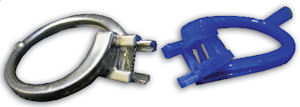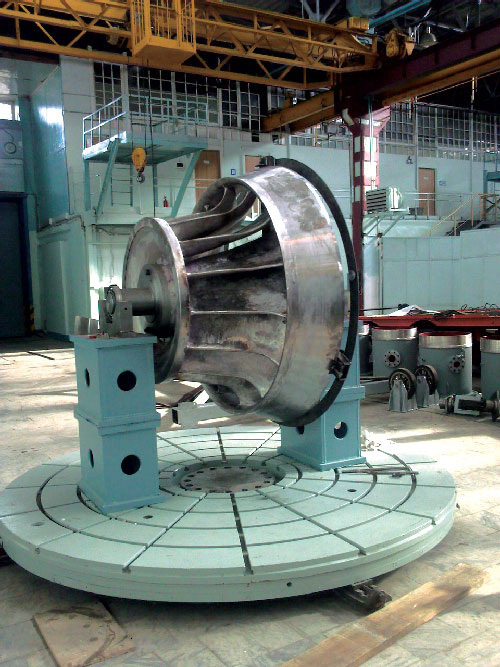Comparing Additive and Subtractive Processes
Cost, volume, geometry and tolerancing are differentiators in what technology to choose for mold making.
May 1, 2012
By Susan Smith
Since additive manufacturing (AM) has been on the scene, the technology has grown in its capabilities—including expanding into the realm of mold making. The AM market itself is growing by leaps and bounds, according to the Wohlers Report 2011. Wohlers Associates predicts that by 2016, the sale of AM products and services will reach $3.1 billion worldwide. The industry is expected to hit $5.2 billion by 2020.
AM offers some advantages to subtractive, computer numerically controlled (CNC) and injection molding.
Case in Point
As a service bureau, VistaTek’s customers range across a number of industries. It has six 3D printers, five of which are Objet machines. Based in Vadnais Heights, MN, its customers include many medical, consumer electronics and consumer goods firms. It also has a number of hobbyists who create their own designs on Google SketchUp or lower-end CAD systems.
Because VistaTek offers both subtractive and additive manufacturing, it can compare the two processes. Allen Mischek, director of AM for VistaTek, says the tolerancing “isn’t there yet for AM.”
 Ring casting created with 3D Systems’ ProJet CPX wax printer. |
However, the ability to make lower-volume prototypes is one reason that AM is growing so fast, according to Mischek: “We use additive manufacturing for patterns for room-temperature vulcanization (RTV) or cast urethane.
“We actually make molds via CNC injection molding in-house, and we usually use our additive manufacturing for one-off prototypes to get the form working, and then we’ll make a mold for our customers,” he continues. “But we do use additive manufacturing in production for fixturing. So in production, we use 3D printing or additive manufacturing for post-processing and fixtures.”
For VistaTek, AM is used as a preliminary process before going to CNC. Some customers use it to build 100 small parts before needing injection-molded parts that have to be built somewhere else. For this, they may use PolyJet processes or Stratasys Fused Deposition Modeling (FDM).
For 3D printing, VistaTek uses Objet’s Kryptogreen, a newer material that is a blend of two materials. It is strong and durable, with good resolution. Objet RG5160 is popular for the soft-touch overmolding abilities. Overmolding is the use of two separate materials for a single cohesive component, a technology for which Objet Geometries is well known.
AM technologies really address complex geometries, Mischek points out.
“If people need parts quick, CNC is not typically done as fast as rapid prototyping,” he explains. “You can do overmolding in Objet where you can’t do overmolding in a CNC machine.”
With CNC, however, you can use real plastics and metals.
“With 3D printing, you have a wide variety of technologies and different metals and plastics, and powders. We have done studies of direct digital manufacturing vs. additive manufacturing and CNC machining and injection molding, and where it makes sense to use each technology. There’s always that break even usage related to material specifics and quantities,” says Mischek. “Those are the main factors as to when you’d use rapid prototyping vs. CNC machining or injection molding.”
Material Durability
Ido Eylan from Objet Geometries in Israel says the company’s ABS-like material that is being printed on Connex platforms allows users to print the same molds and geometries with their previous materials. ABS-like demonstrates a longer life length of the printed tools.
“If I print a certain mold with VeroGray and use it, it will probably last for less shots than the ABS-like material,” says Eylan. “That’s why we feel this application is going quite well together with ABS-like material.”
 3D Systems’ iProTM 9000 SLA Production Center “prints” QuickCast Patterns that reduce the time and cost of producing turbines used in customized hydro-electric power plants. |
The two ABS-like materials Objet manufactures are not as good as metal tools, according to Eylan. Metal tools last longer; they can also have better accuracy and edges.
“On the other hand, it takes weeks to produce them—and with us, it’s only a matter of hours,” says Eylan. “Also, cost is an issue, that depends on where you are. In the Far East, CNC is much cheaper than in Europe and the U.S.”
The prototypes printable on Objet printers can be first-run or short-run for the injection molder to test parts. If customers have to test a design over certain parts, they can print a prototype, but if they want a prototype to be actually tested, the functional testing has to go hand-in-hand with the end material.
“In this case, there is no prototyping platform that can actually do this,” says Eylan. “What we can do now is print the first tool very quickly and very cheaply, inject the real material and then you get the first rough prototype with the end material. This may require more than one tool, depending on complexity, and tool lifespan.”
3D Systems, a company that has acquired a number of companies over the past year in order to offer a broad range of services, helps people get parts printed or developed through a variety of molds and/or patterns—either for multiple prints or even a one-to-one print using some of its technology. 3D Systems currently offers three different categories of devices:
- Personal devices, such as ProJet 1000 for BitsforBytes products.
- Professional products for office environments.
- Industrial professional products.
The latter two categories would use stereolithography (SLA), selective laser sintering (SLS) or Multijet modeling printhead technology (MJM).
Scott Turner, a 3D Systems researcher, says the company started direct metal printing with its technology several years ago.
“It was a two-step process, using SLS as the baseline and infiltration to get you to a near-metal part, but since then we’ve moved forward with other technologies—and even at that same time, we were doing molds and patterns,” he says. “People can get the outputs they want without having to wait for the miracle of direct metal, which is turning out to be very expensive and time-consuming, and also not necessarily perfect for any parts that are over a certain size.”
The quick turnaround, geometry, affordability, automation and lack of waste are key criteria to why people choose an AM process over CNC for making prototypes and molds.
“For a shape that is complex, organic, that has to have fine-featured detail that’s super smooth, it really is better served by using something like additive manufacturing,” Turner concludes.
Susan Smith is a contributing editor for Desktop Engineering magazine. Send e-mail about this article to [email protected].
The Mold-making Process A mold (or mould) is a hollowed-out block that is filled with a liquid like plastic, glass, metal or ceramic raw materials. The liquid hardens or sets inside the mold, adopting its shape. A mold is the counterpart to a cast. The manufacturer who makes the molds is called the moldmaker. A release agent is typically used to make removal of the hardened/set substance from the mold easier. According to Allen Mischek, director of additive manufacturing (AM) for VistaTek, direct metal laser sintering and laser sintering are getting closer to being able to make molds of the quality of normal injection molds. AM is ideal for moldmaking because it can do high-volume, high-turnaround molding. Conformal cooling, or the ability to create passageways for cooling fluids inside a mold, is an area where AM is especially useful. Direct manufacturing refers to direct metal sintering of mold inserts or tooling components. Indirectly, 3D Systems has processes that allow you to create metal objects through a secondary step. For example, its wax printing technology is very proficient at producing wax patterns that can investment casts and any required alloy. They can be used in tooling, fixture and various manufacturing applications. “As you move down to other types of tooling and molding, you get into the low-volume type of equipment—for example, medical equipment,” says Scott Turner, a 3D Systems researcher. Stereolithography (STL) technology is great for creating either mold templates or mold masters, or creating urethanes. Many enclosures that are used in medical devices that don’t exceed 5,000 pieces a year are done using urethane plastics, a material that used to be UL-rated and used in medical environments with blood and other types of biomaterials. This use case competes with compression molding, which requires hard tooling for larger objects, yet does not allow you to create all the features and mechanical components that can be done in injection molding. With 3D Systems’ ProJet series, users can use either the CP, an acrylate that burns out cleanly with wax and support, or the CPX, which is the $100 real wax product where they can cast objects out of that mold. Toshino, a 3D Systems customer, creates huge turbines for customized power plants all over the globe. However, in small areas where it is not possible to build a large plant or the economies are stretched, the company is looking to build the most affordable sized plant it can create. Toshino creates turbines for power plants using STL to create a Quickcast form. “It is a honeycombed structure that is shot with metal to produce the final turbine,” says Turner. “The quality of the Quickcast form is super smooth, and with excellent feature detail. They may do a little CNC cleanup at the end, but the process is 3D printing.” “The sintered metal components we produce can go directly into a larger tool,” says Turner. “An injection molding tool is made up of many different components. To create the core or the major cavity, you can have what are called ‘inserts,’ and those inserts can be fabricated directly in metal in the high-volume, quick-turn injection cycle. This is where cooling comes into play. “Imagine inserts for shoes or other consumer products where every second counts,” Turner offers as an example. “You can create these inserts with cooling capabilities that are not available in a conventionally milled insert, and likewise this gets them into some materials—a lot of sole material technologies is changing and evolving with the designs, they’re using materials that react over time with heat, so having the cooling or heating surfaces as close as possible to the material allows them to hollow out inserts using the additive manufacturing method and mold those. A lot of customers use the printed result like a master. They make a silicone mold out of the master and from that point on, they cast materials into polyurethane or other materials, cast into the silicone mold and have replicas of the original printed part. 3D Systems customers want the benefit of the geometry that its printer offers. For metals, Mischek noted that Matsuura’s Lumex Avance-25 metal laser sintering hybrid milling machine combines 3D laser sintering and CNC machining. Demonstrated at Euromold 2011, it can sinter metal and then after each layer, “it could CNC out.” |
Subscribe to our FREE magazine, FREE email newsletters or both!
About the Author
DE’s editors contribute news and new product announcements to Digital Engineering.
Press releases may be sent to them via [email protected].






